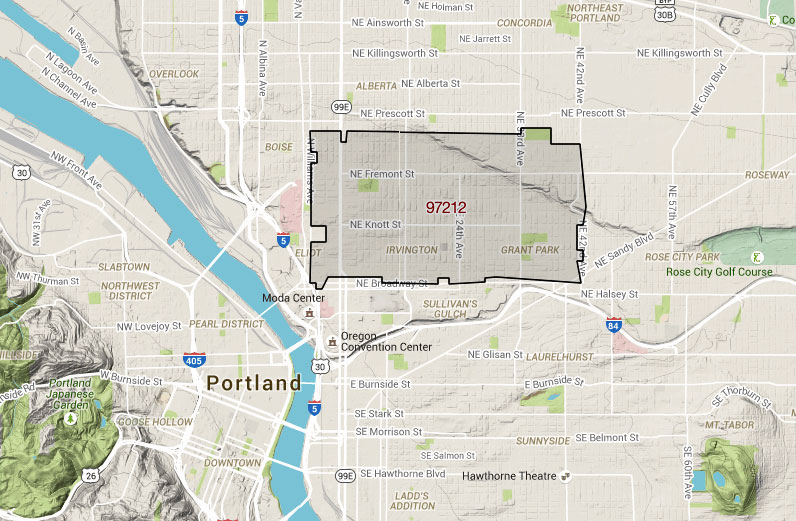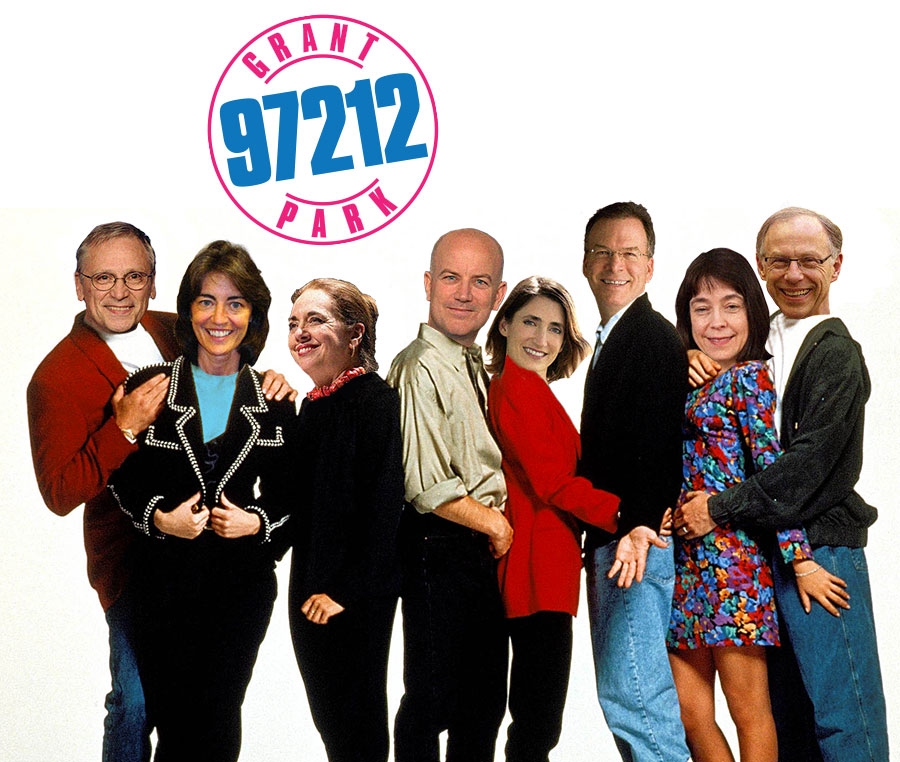What do three Supreme Court justices, the heir apparent to the Port of Portland and Rep. Earl Blumenauer have in common?
We posted a tweet last week about Portland commissioner Nick Fish moving out of his home in Northeast Portland’s Grant Park neighborhood and into an apartment on the west side.
The twittersphere responded with indignation:
Lack of geographic representation on our city council sucks. This would mean ZERO members of council on east side. https://t.co/2Y63biEUId
— Jonathan Maus (@Jonathan_Maus) July 14, 2016
If @NovickOR wins re-election, all 5 members of City Council will live on westside. #nodistricts https://t.co/tsfKeOgI8b
— PDX City Hall Watch (@cityhallwatch) July 14, 2016
Much has been written about the city of Portland’s commission form of governance and concomittant lack of geographic representation.
This is not another one of those stories. What follows is a post about the neighborhood, or more accurately, the zip code, Commissioner Fish left behind: 97212, my own home turf and arguably one of the most politically-connected, overrepresented communities in Portland.
Consider the evidence:
Three Oregon Supreme Court justices — Chief Justice Tom Balmer, Jack Landau and Richard Baldwin — live within 97212 boundaries, an inner eastside tract that wraps in the Hollywood, Grant Park, Irvington, Alameda and Eliot neighborhoods.
Balmer and his wife, Mary Louise McClintock, director of education programs at the Oregon Community Foundation, live on NE 24th street. Their neighbors include Rep. Earl Blumenaeur and his spouse, Margaret Kirkpatrick, former counsel for NW Natural. Close by is Maria Wulff, the longtime president of World Affairs Council of Oregon who retired in May.
Andrea Durbin, executive director of the Oregon Environmental Council, resides about ten blocks east. Her house is a stone’s throw from Fish’s former residence on NE 39th and Knott.
(Jeremy Barnicle, Ecotrust’s new executive director, is also a few blocks away, although technically he lives in the 97213 zipcode.)
Former Multnomah County Chair Jeff Cogen lives in the 97212 zone. So does Curtis Robinhold, deputy executive director for the Port of Portland.
“It’s a great neighborhood,” says Balmer, who moved into his yellow, Prairie-style house — for which he paid $100,000 — in 1985. “There are a lot of politically-minded, socially-involved people there.”
A mix of professionals — doctors and lawyers — live in Grant Park, says Hank Stern, another neighborhood denizen and press secretary to Sen. Ron Wyden. But the community has “more the feel of city hall and county staffers, federal staffers,” he says.
“Come election season, there are probably more lawn signs per capita in Grant Park than almost any other neighborhood.”
The zipcode’s appeal is not hard to fathom. “It’s a combination of good schools, attractive neighborhoods and houses worth putting money into maintaining,” says Kirkpatrick, who moved with Blumenauer into their current home in 1989.
Kirkpatrick, whose husband is known for championing high-density urban design, credits solid land use and transportation planning. “We have these great commercial areas, within easy walking and biking distances, and the schools are integrated into the neighborhoods.”
Fish moved into his Grant Park residence in 1996. “It’s beautiful, has great parks and the good Grant schools,” he says.
As our Twitter followers pointed out, now that Fish has moved across the river, most of Portland’s city commissioners live on the west side. In fact, Fish himself took issue with the premise of this article — that 97212 is home to an unusually large number of elected officials and other community leaders.
“Three city commissioners — Steve Novick, Dan Saltzman and Amanda Fritz — all live in or near Multnomah Village,” he says. “You could write an article about that zip code.”
Certainly one can find other examples of politically influential neighborhoods. But the 97212 cluster is notable, in part because it suggests the epicenter of power and wealth in Portland is continuing to shift away from the westside.

“One way to think about it is mayors,” says Stern, a former managing editor for Willamette Week who also covered City Hall for the Oregonian. “Vera Katz was from the west side; Tom Potter, Sam Adams and Charlie Hales were from the Eastside.”
Back in the day, it was also difficult to find city council candidates north of 39th (now Cesar Chavez avenue), Stern says.
Plenty of business and finance leaders call 97212 home. Nike design legend Tinker Hatfield, for example, lives in one of the neighborhood’s stately historic mansions.
But Grant Park differs from Portland’s “old power elite” neighborhooods, says Balmer. He distinguishes between the West Hills and Dunthorpe, “where you are likely to find more business people with a lot of money,” and Grant Park, which is more economically diverse — relatively speaking.
Balmer points to the modest bungalows north of Knott street as an example. Grant High school feeder schools are also more diverse than West Sylvan and Bridlemile in the West Hills, he says.
Cultural diversity is another neighborhood marker, Balmer says. Cheryl Strayed is one of several prominent writers and musicians who live in Grant Park (although it is precisely their celebrity status that might preclude any claims to diversity).
Kirkpatrick echoes Balmer’s sentiments about the neighborhood. “For people who are interested in public policy, the idea of being in a neighborhood that is more diverse than Dunthorpe and the West Hills is important,” she says.
Many of Kirkpatrick’s friends moved to the west side once they become more established in their careers. “But we didn’t want to move across the river to some of the other areas because they are uniformly affluent and white bread. We wanted a little more variety, more texture.”
Therein resides the true appeal of Grant Park. It’s a wealthy neighborhood with great schools. But the zip code also has enough social, racial and economic diversity to make it politically palatable for the city’s progressive class.
Sixty five percent of the students who attend Grant are white, 13.5% are African-American and 23% qualify for free and reduced school lunch. That’s less diverse than Jefferson, where 56% of students are African-American — but more diverse than Lincoln, which draws on West Hills neighborhoods and is 83% white. Three percent of Lincoln students are African-American and 11% are considered economically disadvantaged.
Whether Grant Park can still be considered mixed income as housing prices continue to skyrocket is not a subject for debate. As of June 2016, the neighborhood’s median home value was $660,600.
“Grant Park is a politically-aware place and that translates into political impact,” Stern says. But he too pointed to elected officials who live in other neighborhoods: Charlie Hales lives in Eastmoreland. Senator Wyden lives in southeast Portland, when he’s not in Washington D.C. or New York City, where his wife and three children reside.
By definition, Oregon state legislators are scattered around the state. Senator Jeff Merkley, who has made living in a working class neighborhood a political statement, resides with his family in outer east Portland.
“I have never looked at a map showing the concentration of elected officials,” Kirkpatrick says. But she says it would be a concern “if it looked like there was a huge cluster.”
Fish disagrees. The commissioner, who moved last week into the Vista St. Clair in Goose Hollow — he and his wife and 12-year-old son now live on the same floor as former mayor Bud Clark — mounts a spirited argument decoupling neighborhood and political influence.
“Zip code is not destiny,” Fish says. “Zip code alone is not great indicator of politics or things you work on.” Bud Clark was considered the most populist mayor in a generation, yet he lives on west side, Fish says. “After 20 years I’m going to be leaving inner northeast. But I’m still going to be an eastside guy on the council.”
Fish says his family moved to be in walking distance of his office and his son’s Spanish immersion school. “I was frankly done” with homeownership, he adds. “It’s where this city is headed: a smaller footprint, less car dependent.”
Besides, Fish says: once upon a time, most council members lived in northeast Portland. “After Ted Wheeler takes office, no one will live on the east side. Things change.”
But the more things change, the more they stay the same.
The story of Grant Park is an old story: how human beings tend to sort themselves by race, class and interest. It’s also a Portland story, about how to create cities and neighborhoods that mitigate those tendencies — especially now, as an unprecedented market boom continues to push money down from the hills, into the city and across the river.
Nick Fish doesn’t live in Grant Park anymore. But he’s probably right. It really doesn’t matter.
Correction appended: This article has been amended to reflect the following corrections. Senator Wyden does not live in Dunthorpe. He lives in SE Portland, and he and his wife have three children.



